BONUS BOBCAT 1982
The autumn weather and sun angle triggering
Photoperiodism
has caused the majority of the tree leaves to turn to beautiful hues of rich
browns, fire reds, golden yellows and brilliant oranges with various mixtures
of the rainbow colors and have fallen to the ground like droplets of rain and
suspended aloft momentarily at times by the thermal currents of the wind.
The wind is getting much more brisk of late biting into your bones as if you
have no protection at all from the elements provided by the numerous layers
of clothing worn. Acorns have already made their annual decent to the ground
below from the lofty mighty towering ancient oaks that are scattered on the ridge line
overlooking a small creek that runs into an old canal that is fed from the
Pee Dee River, Blewett Falls Lake that once powdered a
grist mill of which
was long gone around the early 1900s. This is the area I plan to hunt
this 1982 archery season looking forward to being able to enjoy what God has
created for all of us if we only take the time to utilize those resources.
Long before White settlers
inhabited this area, Native Americans hunted these same ridges and bottoms
as evidenced by the stone arrowheads and spear heads found nearby. By the
vast amount of rock chips and incomplete arrowheads and spear points, the place I
found was no doubt where the Native American Craftsman had his campsite
sitting hours upon hours chipping away with another stone and sharpened
antler tip lashed with leather strips to a piece of wood used as a lever and fashioned those
stone points and arrowheads of which some of those artifacts I would
classify as seconds not meeting the arrowhead and spear head maker's
standard and were simply discarded close by. The arrowhead maker
probably protected himself from flying chips by having a coat of mud over
his face and exposed arms and hands and used a piece of Buckskin to protect
the hand holding the piece of stone since pressure from the antler tip
caused a chip to be removed from the back side of the stone being chipped
leaving a razor sharp cutting edge.
Prior to the actual chipping of the stone, he no doubt reduced larger chunks
of his raw material into suitable working sizes called "pre forms" which
could have been volcanic glass (obsidian), quartz, flint and a variety of
stones he either found himself or barter and traded for from other areas.
The Native Americans lived in a time without restraints and limitations as
to time and their primary objective was to have the basic necessities of
life; food, clothing and shelter and the protection from neighboring tribes.
On can only imagine the chaos, pain and suffering the Native Americans
experienced when White settlers moved in and took what was rightfully
theirs. Below pix of some of
the arrowheads and spear points that I did not mount under a glass frame but still had
stored in a machinists tool box:
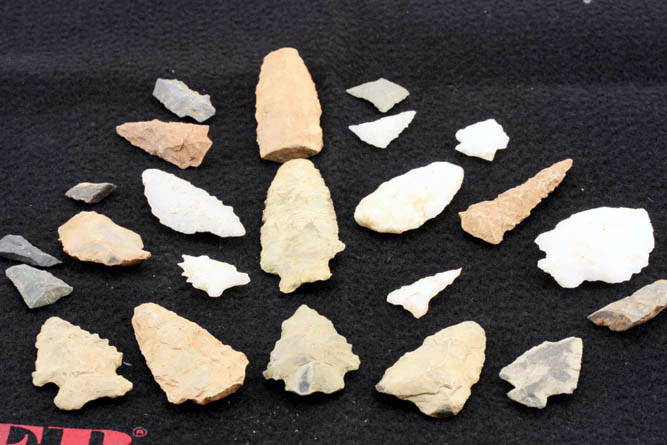
At this time of the year, deer quickly devour the Willow Oak acorns first along with the White Oak acorns since they are the least
bitter and will finish off the Red Oak acorns which has more tannic acid in
them which translate to much more bitterness. I know this personally
since I have tasted them just for the experience of knowing first hand! One can only wonder what the
scene would have been like about the time when the old grist mill was in
full operation with the local farmers bringing their loaded wagons drawn by
laboring mules, oxen or horses with the wagons bulging sacks of corn, wheat, barley, etc to be
ground into meal, flour and grits. But alas, such scenes are now gone
and committed to eternal memories from the past and ones own imagination unless some ole black and
white photographs or etchings have survived to more accurately tell the tell. The only remnants left of
those by gone years is the hand dug canal which might be passable by canoe
although the years has caused the once steep rock lined banks to erode and trees have
fallen into and across the banks of the canal with sediment deposits from the
flowing muddy river have reduced the depth to a couple to 3 feet in places.
The two large
circular granite rock grist mill grinding stones which have a round hole
bored through them of which one has extra slots cut from the center hole for
attachment to the water powered wooden drive shaft are close by the canal resting there for over a century. The
ole moss and plant covered grist mill stones have occupied their silent grave
for many generations and if they could only tell of their origin no doubt
mined from the rock quarries of mountains in France and transformed into the
grist mill stones by the state of the art process at the time which incurred
a tremendous amount of physical labor from stone craftsmen. Those
stones would then be shipped in the hulls of the ships as ballast to the few ports in
North America and transported via railway (those that existed) and then
finally by oxen to their current location. It
had to be a tremendous task to construct an operational grist mill during
the middle 1700s and 1800s from the ground up and I am sure if we could
personify those stones, they would have many stories to tell about the
decades they
labored and what had transpired since the demise of the ole grist mill as
they now lay silently in their above ground tomb never again to feel the
kernels of the farmer's harvested grain transverse between them yielding
sacks of flour, corn meal, grits and feed for livestock.
Pixs below of the stones referenced above at their present location and
the story leading up to their removal from the ole grist mill site at the canal:
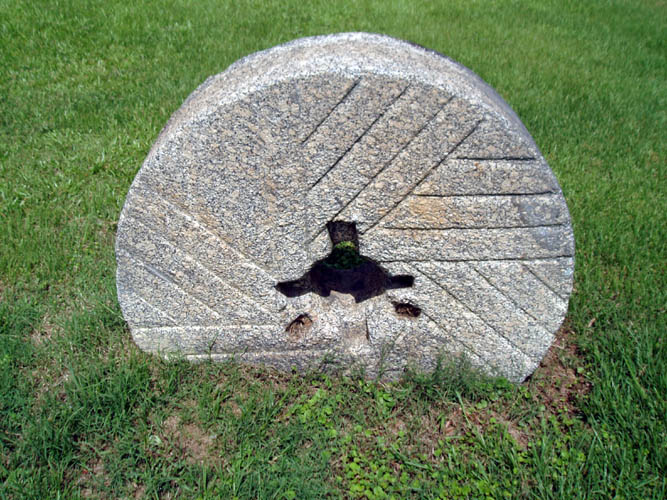
The above stone is the upper stone called the runner stone which rotates
slightly above
the bottom stone called the bedstone which does not rotate.
Both these stones are 46 inches in diameter and are 14 1/4 inches thick and
no doubt weigh close to 2000 pounds each and research reveals they would be
capable of grinding about 300 pounds of grain per hour. Operational water driven grist mills today have covers over them and you
cannot actually see the inside operation of the grist mill stones in action.
Below is the bedstone which does not rotate:
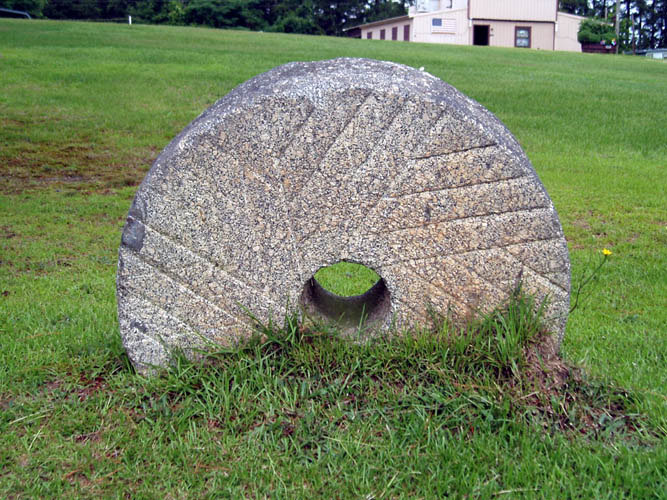
When viewing the stones face up, the furrows and lands have identical
patterns but when they are installed their pattern is opposite which
accounts for the shearing action of the two stones like a pair of scissors.
In operation, the upper runner stone is slowly lowered while spinning
very close to the lower bedstone which is stationary and grain is fed into the
stones from a hopper above the center of the runner stone and grinding takes place. The grist mill
operation is far more complex that one would imagine and the stones have to
be surface dressed near perfectly flat to keep a good sharp shearing action between the stones like a
scissor and the furrows also have to be chiseled as well to maintain a
square edge as depicted in the drawing below:
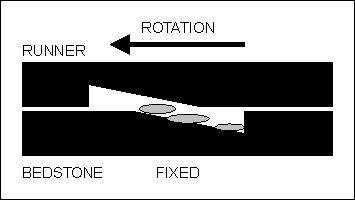
The grooves in the stones are called furrows and help channel the
ground grain and husk to the outer perimeter of the stones where it is collected,
sieved and graded
into collection bins. A few close up pixs of the stones:
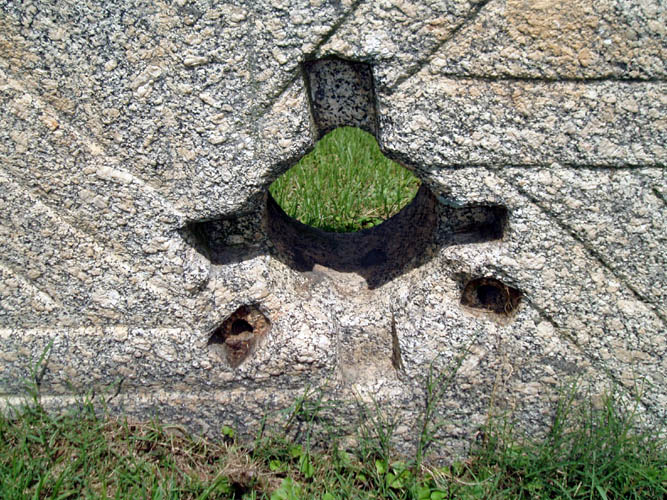
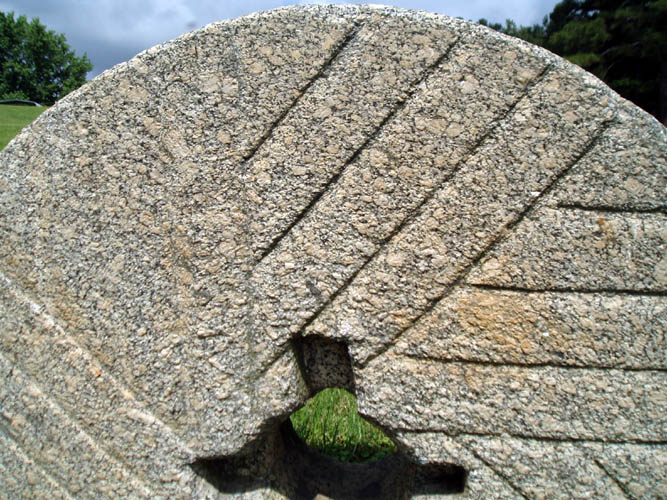
The granite grist mill stones at their original resting place adjacent the canal were hidden
from normal view by small trees and undergrowth that had grown around them
and only visible by a very close inspection from the more curious observer
and had settled into the ground a good amount. Before
the stones were removed adjacent the canal to their current location, the furrows used to grind and cut the
grain like a pair of scissors, as well as move the grain outward from the
center of the millstones to the outer circumference and the furrows were
also used to
increase the air space between the millstone to keep the grind cooler
were still readily visible even with all the moss, etc after over a century
of resting there. Below is a .gif animation of how the stones work
together:

Below is a pix taken
many years later of the permanent tree stand that I took my first deer with
bow and arrow from and the granite grist mill stones were about
30 yards from the tree stand and slightly to the right where the ole grist
mill and logging road made a sharp bend also to the right and not too many
yards from the flowing canal. The tree
had been dead quite a few years when I took this picture with my ole Nikon
F2AS 35MM film camera and the dead tree is leaning to the right in
preparation for its final resting place onto the ground to be transformed back into the
elements of the earth from which it sprang forth:
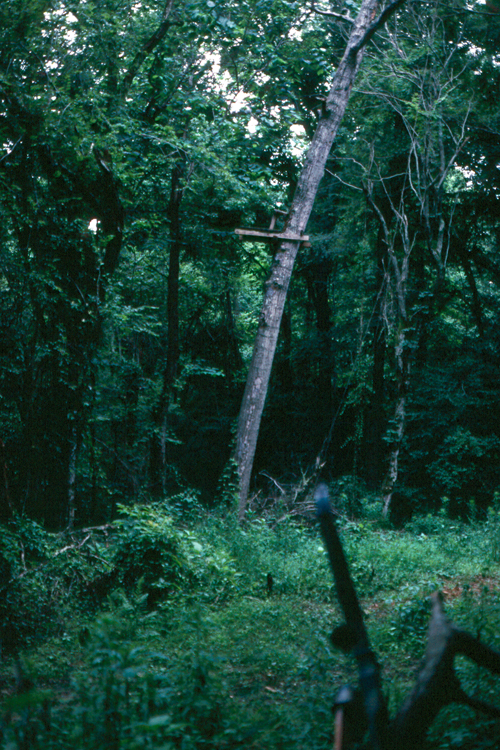
About a month ago, the stones found a new home as I will describe. This 2,810 acre track
of land formerly known as the Dr. Davis Estate Land was sold to the
Catawba Timber Company with the N.C. Wildlife Resources Commission leasing
and/or managing the land as Game Lands. I was bowhunting about 30
yards from the location of the grist mill granite stones one cool late
autumn morning when I heard a dozer approaching from the entrance of the
grist mill road which had grown up and only a small path at the most. By
the sound of the dozer it was getting closer and closer and decided my morning
hunt was definitely over by all the loud noise created from the dozer’s
laboring engine. I took my time and got down from my tree stand which was a
portable climbing tree stand and was very close by and in full camouflage
clothing with face painted and all when the bulldozer approached and was
following the old ancient grist mill road bed widening it with the dozers
blade pushing small saplings and other debris out of its way when it hit
one of the grist mill stones with a loud bang of which the dozer operator stopped to
investigate what he had ran into. As the dozer operator was inspecting the
granite grist mill stone, I walked up from behind him and said,
“Hello” of which he jumped about a foot or more off the ground in total
fright and horror as if something had gotten hold of him. We both got
a tremendous grin from that and asked him his name and he replied that he
was, “Francis Burr” making a road for logging equipment. Francis said
that no way he would have ever imagined someone would be this far from the
paved road and we chatted a few minutes. I guarantee you he has not
forgotten that incident to this date. Francis Burr later came back and
moved the granite grist mill stones to their current location which was
utilized as yard décor. It seemed a pity to remove those ole
stones of which it is easy to personify them as if they were a living object
but I guess its done in the name of progress.
I planned to hunt the ridge adjacent the grist mill canal about 100 yards up the
canal where I had observed a
fresh deer scrape which had a lot of rubs in the area with several deer
trails along the lower crest of the ridge where the deer were apparently
feeding on acorns and by the amount of rubs and scrapes, one large buck was
certainly in full rut. The previous year, I bow hunted the same area
but never got a look at the buck which was mostly nocturnal. I heard
him once before daylight while approaching my hunting stand and later in the
day found a fresh rub where I had heard him. This particular buck I
named Phantom because he was so
elusive. He had about 3 or 4 scrapes in this vicinity but never once
did I see him visit any of those scrapes during daylight hours but he kept
them fresh by the smell of the strong urine that was in them. I was
hoping that the fresh scrapes of this season was his and get a chance to
make a fatal shot on him but again, he is the Phantom. The white oak and
red oak trees near Phantom’s scrapes and rub line were too small to support
a portable tree stand and had to settle further away from the trail about 30
yards which is still within my shooting limits with the bow and arrow to
select a suitable tree that wasn't too small or too large.
I placed my portable Baker Pro Hunter model tree stand on a suitable sized
red oak tree and had to get about 24 feet off the ground to have a good view
of the trail and really didn’t know which direction the buck worked his
scrape line from. The Baker tree stand platform is 24 x 32 inches but
is a little too flimsy for my 200 lb. plus frame but could secure it to over
a large limb and used a set of
Bashlin aluminum alloy climbing gaffs to get up and
down the tree which is still somewhat dangerous. The upper gripper
blade was lashed with small rope to keep it from moving. Everything was now
ready to try for the Phantom buck.
My wrist watch alarm went off at 5:01 AM and the large king sized bed with
the electric blanket and additional cover felt very good and I debated
whether or not to get up. The thoughts of touching the cold wood floor
just about won out but a hunter is not rationale most of the time. I
eased from the covers and when both feet hit the ice cold floor it didn’t
take them long to get out of that bedroom where there is carpet and is a
good bit warmer living area. I dialed the local time and temperature and it was 48
degrees and decided to wear some insulated & filled under pants and shirt
since I would be hunting with the wind coming from the North to North West
and a good 16 mile drive from our home not to mention a good 20 minutes of
brisk walking to access the tree stand. I also put on brown camouflage
hunting pants and a long sleeve pullover shirt with a light weight
camouflage hunting shirt. My hunting equipment was a Brown Bear 2
wheel compound bow set at 67 pounds and using 2018 XX75 autumn orange arrows
tipped with Wasp camlock 145 grain broads and had a homemade cable guard bar
installed and a Flipper arrow rest and an adjustable Berger button.
The quiver was a detachable Kwikee Kwiver with 6 arrows. I usually
carry a fanny pack which is the USMC surplus and on a regular pistol belt
with a set of army suspenders. On the belt is a 1 quart plastic
canteen, small Eastwing hatchet, fanny pack, ammo pouch which carries a
rangefinder and a small Army surplus pouch that contains a compass and a
small bottle of deer sent. There is also a small pouch that contains a
plastic scent vent of buck lure attached to one of the suspenders. I
usually carry a 30 feet nylon rope with a snap on one end to pull the bow
and gear up the tree after I am safely buckled to the tree with a safety
strap. Depending on the stand, I carry a set of Bashlin pole climbers
to get up the tree and this particular tree stand will require their usage.
I plan to leave the tree stand at that location until the seasons end or
might decide to move it before then. The fanny pack contains the usual
stuff such as first aid supplies, spare bow string, broadheads, emergency
gear, plastic bags, fluorescent orange ribbon, tissue paper and other things
including a knife which is enough gear to last a week on a Safari hunt.
The day prior to this hunt had a continuous light to heavy rain that lasted
until about 10 PM and the following morning was very clear with the stars
shinning out of the dark sky. The moon was about 1/2 full and still
out, maybe not the best time for hunting early in the morning but with the
rut on and reasoned the deer would be on the move this morning. The
drive took about half an hour winding through some beautiful farm country in
the Southern piedmont section of Anson County near Blewett Falls Lake. The
walk to the ridge took about 20 minutes at a normal pace or somewhat slower
pace to not generate enough body heat to perspire and give my position away
to the deer population. While in route on an old logging road there
were numerous deer tracks made during the night following the rain.
This helped me psychologically as I figured the deer would continue to move
this morning or at least I hoped as much. Prior to leaving my parked
car, I put 2 green felt strips on each boot lace that I had soaked in Red
Fox urine since I would be crossing a couple deer trails getting to my
stand. I also unscrewed the scent vent of skunk essence pinned to my
camouflage shirt in hopes the scent would overpower my own scent as I walked
toward the ridge.
When I reached the stand at about 6:10 AM, I put my bow down and uncoiled
the 30 ft. nylon rope. Then walked to the fresh deer scrape and
dropped a few drops of doe-in-heat lure near it and back tracked down the
trail to my stand sprinkling a few drops of the lure on the brush and leaves
about waste height in hopes of luring the Phantom buck on up the trail to me
in case he did not approach from my direction. There is too much cover
between my stand and the scrape to attempt a shot with an arrow so was
counting on the lure to hopefully work. I also placed two felt strips
soaked in the lure on each side of the trail about 10 yards from my stand in
a small clearing that would be an easy shot from the stand. I further
placed some pure buck urine taken from a large 6 point buck in November of
1981 that was stored in a 35MM film canister and placed on a rotten pine
tree stump near the deer trail in hopes of setting a trap for any deer that
might happen along. With my so called deer lure trap set, I put the
climbing hooks on and climbed the tree and got into position. Its
dangerous climbing in darkness with a pair of pole climbers and extreme
caution was taken each time one of the spikes was pushed into the tree
before the other foot was removed. The next thing done was attaching the
safety strap around my waits before I did any moving around on the tree
stand. The pole climbers were removed and hung on a limb and the fanny
pack and suspenders were hung on one of the extending side rails of the tree
stand. My bow was drawn up the tree and also hung on a limb. I
removed the detachable quiver from the bow and attached the quiver to one of
the stand front rails which had a bracket attached to it for that purpose
and you can easily remove arrows as needed from the quiver. The wind was
blowing and a little chilly but the layers of clothing felt very warm indeed
and it was around 6:30 AM and the sun didn’t rise until around 7:00 AM.
The thirty minute sit in the fold down seat wasn’t too uncomfortable but
bearable while thinking of the Phantom buck slowly and cautiously slipping
around in near silence inching his way toward his fresh scrapes. Such
thoughts can cause ones vision to materialize a deer from the shadows and
overhanging tree branches with only the rising sun to erase them completely.
With the sun coming up, the fog began to come in causing visibility to
shorten to less than forty yards and the chilly autumn and early winter air
caused my feet to feel like miniature and my ungloved right bow hand getting
somewhat numb for the cold breeze.
As the sun slowly made its ascent, the fog began to lift and vaporize and
the birds began singing their melodious songs and it reminded me of the
previous spring and fall mornings. A grey squirrel emerged from a
large dead tree about 25 yards in front of my stand and traveled along its
decaying weather beaten limbs to a large white oak tree in search of any
remaining ripened acorns that had not fallen to the forest floor below.
A close by Brown Thrash bird has spotted me and cannot quite understand what
I am or what I am doing in this white oak tree and is very inquisitive
turning his head from side to side and will only approach to within
about 3 feet. I remain statue like and play a silent staring game with
him and his curiosity is finally eased and he flew off
to another location.
Approximately an hour and fifteen minutes has passed since settling down in
the tree stand without seeing or hearing a whitetail deer. Suddenly, I
hear a rustle of the dry leaves to my right about 40 yards away and see a
movement of something brown walking rather fast. Its long brown
slender body, short stubby tail, upright poised ears and unusually long legs
reveal it’s a Bobcat. The Bobcat is moving in a half circle rather
stiff legged and it apparently came from beneath the crest of the ridge and
is in search of food. The bobcat headed for the deer scrape and when
it winded the doe in heat lure I had sprinkled a few drops on the ground at
the scrape, it began to follow the trail I laid from the scrape to my tree
stand. I had put a few drops every 3 or 4 feet apart on leaves and
branches beside and in the deer trail up to a small opening about 10 yards
from my stand. The Bobcat went to each one of the lured places and
smelled them and continued to walk up the trail toward my stand. By
this time, I had eased from the fold down seat
and stood upright with my bow ready. The Bobcat slowly walked in the
clearing toward the last lured spot and I drew my arrow back to my anchor
point and placed the 20 yard sight pin on his neck and shoulder. The
Bobcat was standing lengthwise from me and I knew my arrow would probably go
a little high since he was only 10 yards from me although I didn’t am low to
compensate. At about the instant I was at full draw, the Bobcat looked
directly up at me. I knew it would not wait around to figure out what
I was so my arrow was released. The arrow hit fairly solid giving a
thud type sound upon impact and the Bobcat spun around quickly although its
dexterity was very uncoordinated smacking into the undergrowth while it ran.
It took a path similar to the one it had taken to my stand but veered off to
the right of it from my stand. I figured the Bobcat was hit very well
and that to continue on the stand waiting for deer would be useless. I
hung my bow on a limb and put my climbing hooks on and then lowered my bow
and fanny pack to the ground and descended down the tree. The feel of the
ground beneath my feet certainly did feel good.
My pulse and blood pressure was at a maxim due to my excitement and anxiety
was building until I could verify a hit and kill on the unlucky Bobcat.
This Bobcat was the second one I had seen in the wild and I certainly
considered it a trophy. The 25 feet climb down to the ground took far
less time than climbing up and my adrenalin had to be working overtime at
this point. After getting down from the tree, I immediately checked
the arrow which was stuck in the ground a few inches at the same angle that
it was when it left the bow. The arrow was covered with blood and the
broadhead had a good amount of hair embedded between the blades. A few
feet from the arrow, I found a piece of white fatty looking tissue
about 1/8 inch in diameter and about 3 inches in length and thought it might
have come from the Bobcat’s stomach area. I continued to search for a
blood trail but there just wasn’t one. I went back about 20 yards from
the hit site and made a circle looking for sign and clues as to what had
happened. I got down on hands
and knees and looked but still couldn’t find any sign. The leaves and
ground was wet with the morning due helping to camouflage the sparse blood
trail which had to be there from the looks of the arrow. I continued
the search in larger sweeps and spent a couple hours to no avail. I
really felt like giving up and reasoned that I had made a gut shot or that I
had only grazed the cat instead of making a fatal hit. I then went
back to the arrow and last sign and got down again on all fours and searched
for more sign. By now the leaves and ground was drying and the
temperature was climbing into the low 60s and I had to remove a set of the
quilted under clothing to keep from having a heat stroke. I finally
found some very small blood splotches and marked the spot with a Kleenex
tissue and continued to look for more sign. Without getting down on
hands and knees it would have been nearly impossible to see the small dried
blood stains on the leaves. Also, this late in the year, the maple
leaves had similar blood color adding to the difficulty in following the
sparse blood trail. About every five or six feet, minute blood stains
would be found and occasionally a much larger blood stain would be found. By the type of
blood stain, it appeared that the cat had moved very quickly through the
area because the blood was not deposited in droplets but have been smeared
and splattered. Two times the cat had rubbed its right side on small
sapling trees which left a blood stain about 12 to 15 inches from the ground
it covered about 6 to 8 inches in length and the blood had ran down the
sapling forming a droplet at its base. I now figured I had hit the
Bobcat on its right side somewhere near the stomach area. This sign
was found about 70 yards from the hit site and the cat was now making a
circle back to the lower end of the ridge heading for the small creek.
Many times the blood trail was lost and the blood stains were getting much
smaller and farther apart. Sometimes the stains would be less than the
diameter of a pencil lead but at least it was still present and able to keep
following the blood trail.
I cut a small sapling about 3/4 inch in diameter and made a flag with it
since my tissue paper was about used up and I back tracked and retrieved
some of the tissue to aid marking the sparse blood trail. I would
place the flag on the last blood or hair sign. Not too far away, I
found some partly digested rabbit hair matted together and was certain the
arrow had entered into the cat’s stomach or intestines. I also knew I
had a long hard trail to follow and that there was a possibility that the
blood trail would eventually be lost when the cat bled out or the wound was
closed by its intestines. This tracking business is hard working
indeed but only ones determination and tracking skills of which mine was
limited due to inexperience can make the difference between success or
failure. I was determined not to give up and to follow the trail until
I knew there was no trail left to follow.
At one point near the ridge where it gradually tapers down to a deer
crossing where a small wet weather branch feeds into the small creek that
runs parallel with the ridge, the cat went to the roots of a blown down tree
and traveled the length of the tree as if trying to hole or den up.
The cat continued down the ridge and its trail led to the edge of the creek
where all indications was that it entered the creek. A few days prior
we had several days of light to heavy rain and the banks of the creek were
swollen and there was no way to cross the creek without walking a mile or so
and then there was low places on the other side that would make traveling
very difficult. This area is very dense with bamboo and thick
undergrowth laced with sting nettle plants about waist high that will put
some serious whelps on your skin upon contact and as its name implies,
STING. These sting nettle plants have very small needle like spines on
them and will pierce through a couple layers of regular clothes and leave a
painful, itching string and whelp on your skin…..been there done that!
One other possibility was left and that was to come up the river by boat and
walk straight to the creek from the river and made the decision to do that.
I went back to my stand which was over 100 yards away and gathered my pole
climbers, fanny pack and other gear and hiked back to my vehicle. I
wasted no time returning home and getting my boat and trailer hitched up and
went to Blewett Falls Lake and put in at the Old Boat Landing. It took
about 20 minutes by boat to get to the ridge running the16 feet John Boat
powered by a 50 HP Mercury outboard motor tacked out at 5000 RPM leaving a
good length rooster trailing in the air behind the boat. I had a power
trim until installed on the motor and could plane the boat out with only a
couple feet of boat bottom surface making contact with the water surface.
Upon arriving at the area about directly in front of where I had tracked the
Bobcat to the creek, I anchored and it took another half an hour to walk
from the Pee Dee River, Blewett Falls Lake to the creek adjacent the ridge.
As I said earlier, the sting nettle surely does hurt and I trampled them
aside the best I could getting through the thick swampy area which probably
isn’t more than 200 yards in width to the creek. I finally found the
deer crossing at the base of the ridge where an old platform
deer stand still remains although not usable in its current condition.
I located the tree across the creek where the cats blood trail had ended
upon entering the creek which is only about 10 yards wide at that particular
place. I started looking around for sign at the creeks edge and
noticed that the water level had dropped about a foot since the morning.
I continued looking and as I came directly in front of the last Bobcat sign
on the other side of the creek, I spotted the Bobcat to my left lying at the
waters edge. Why hadn’t I noticed the cat from the other side of the
creek earlier? The cat must have been under the water or either it was
so well camouflaged that I had just overlooked it.
It felt relieved that I had located the Bobcat, but I was saddened that the
cat had to travel so far before death took its eternal grasp. My arrow had
entered on the right side behind the rib cage and exited at a slight angle
in the lower intestines. The cat’s lower intestines were extended
about a foot behind it. One can only imagine how it traveled so far
with such internal damage done. I expect the determination to survive
and exist can be paralleled to ourselves since all things great and small
desire to live even the ones we take for granted like domestic cattle and
birds.
The question I raised is why did I shoot a couple of inches to the left at
such a close distance? I remembered that I had earlier set my
adjustable Berger button in toward the riser of my bow and had readjusted my
sights because I recently switched from 2117 arrows to the 2018 which are
smaller in diameter and the arrows were in the ball park; e.g. 2 to 4 inch
groups at 20 yards which is
sufficient for deer, but an animal the size of a Bobcat presents a much
smaller target in body width.
In bowhunting as in other sports, there is very little margin for error and
equipment must be maintained and adjusted for maximum efficiency,
performance and accuracy. The Bobcat was a female and didn’t weight it
but it must have went about 30 pounds. I plan to have the Bobcat
mounted and look forward displaying the Bobcat. This Bobcat has taught
me several things about being more prepared which I hope will make me a
better bowhunter and Sportsman. Below pix of the mounted Bobcat which
I wasn't pleased with the amateurish job:
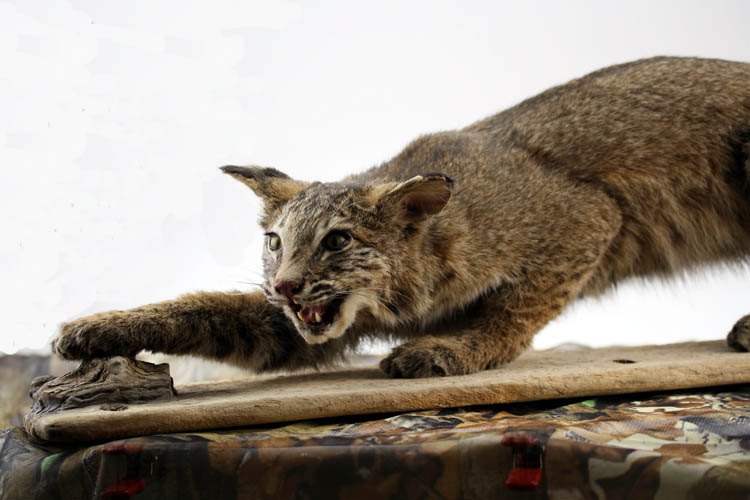
Above hunting short story was hand written sometime in late 1982 and typed
and edited with a few additional comments on 06-07-13 with pictures added
on 06-08-13.
The following year 1983, I harvested my first deer with
traditional archery equipment
commonly referred to as "stick n string"
a couple hundred yards from this area adjacent at a small tributary of
Savannah Creek and still locked into the memories from the past:
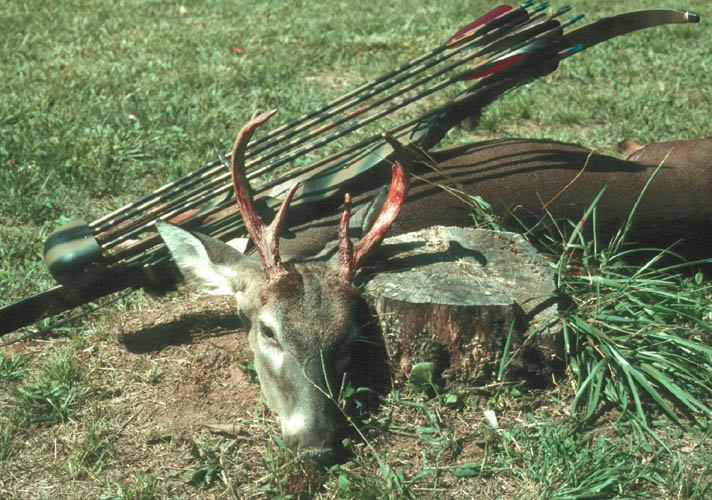
NOTES: Since that 1982 Bobcat, I have taken one other Bobcat
with archery equipment and two others with a .270 Winchester. The other
three (3) were taken from the same field near Cason’s Old Field, lower part
of Anson County, North Carolina. The other archery Bobcat was observed
at the end of a soybean field approximately 200 yards in length and I got out a small rabbit in distress mouth
call made by
Burnham Brothers and gave a few rabbit in distress squeals and
the cat headed straight to my call. About 40 yards out I had placed a
scent vent with some deer urine and had the plastic Zip-Loc type plastic bag
in the small ditch nearby of which the Bobcat went directly
to the deer urine and pressed his head and neck against the plastic bag as a
dog would do. I gave a couple more low volume rabbit in distress
squeals on the mouth call and he headed directly toward me and stopped
within 17 yards of which I judged the yardage as 20 yards and missed him
with the first arrow of which the Bobcat whirled around and slapped at the
arrow fletch when it hit right beside him. I was lucky enough to nock
another arrow while he was observing the arrow and slowly drew my bow back
and held the 20 yard sight pin several inches low on his vital area and make
a clean kill shot with the cat only going about 40 yards. I gave the
first Bobcat taken in this story to one of our local Taxidermists and after
three (3) years had not received my Bobcat mount and finally upon pressing
him several times, he supposedly had someone else do the mount for me which
looked like a rat t--d in a flower sack; very unprofessional. I was
very disappointed with the mount but the memories of the deer hunt that
turned into a Bonus Bobcat still lives on.
I drove to Lilesville, NC this morning and took a few pixs of the ole grist mill
stones final resting place near the intersection of Ingram Mountain Road and
Stanback Ferry Road on property owned by Mike Goodwin which has storage
buildings for rent on his property. You can see a large chip out of one of the
stones (bedstone) perimeter no doubt caused by contact from the bulldozer's
blade that Francis Burr was operating in 1982 when he ran into them.
I also talked with Susan Burr this evening and she related to me that
Francis had passed away in 2005 and certainly sorry for her loss. I was hoping to refresh his memory
about those stones but time waits for no one and certainly thankful for each
and every day the Lord allows us.
God Bless!
Written in 1982 by William M. Porter,
Web published by Bill aka Mickey Porter 06-07-13 with updated pixs on
06-08-13.
LEAVING ON A
SPIRITUAL NOTE
If you do not know Jesus Christ as your Lord and Savior, please take
this moment to accept him by Faith into your Life, whereby Salvation
will be attained.
Ephesians 2:8 - 2:9 8 For by grace are ye saved through
faith; and that not of yourselves: [it is] the gift of God: 9 Not of
works, lest any man should boast.
Hebrews 11:1 “Now faith is the substance of things hoped for,
the evidence of things not seen.”
Romans 10:17 “So then faith cometh by hearing, and hearing by
the word of God.”
Open this
link about faith in the King James
Bible.
Romans 10:9 “That if thou shalt confess with thy mouth the
Lord Jesus, and shalt believe in thine heart that God hath raised him
from the dead, thou shalt be saved.”
Open this
link of Bible Verses About Salvation,
King James Version Bible (KJV).
Hebrews 4:12 “For the word of God is quick, and powerful, and
sharper than any two edged sword, piercing even to the dividing asunder
of soul and spirit, and of the joints and marrow, and is a discerner of
the thoughts and intents of the heart.”
Romans 6:23 “For the wages of sin is death; but the gift of
God is eternal life through Jesus Christ our Lord.”
Romans 3:23 “For all have sinned, and come short of the glory
of God;”
Micah 6:8 “He hath shewed thee, O man, what is good; and what
doth the LORD require of thee, but to do justly, and to love mercy, and
to walk humbly with thy God?”
Philippians 4:13 "I can do all things through Christ which
strengtheneth me."


